|
February 19, 2023
Dear Neighbors and Friends,
I hope that you and your loved ones are doing well, staying healthy, and looking out for your neighbors and friends during this past week.
In tonight’s newsletter you’ll find an update on the bill-reading that (unfortunately) remains an everyday occurrence in the Oregon Senate You’ll also find more on the next legislative deadline that arrives this Tuesday. Plus a report on last week’s Senate Education meetings and the public hearing on SB 530, the Natural Climate Solutions Act.
On the COVID front, we continue to see small increases in most of the COVID metrics (as opposed to flu and RSV, which remain sharply lower than they were). According to the new forecast released this week by OHSU, hospitalizations should continue to rise slightly and peak in two weeks.
For those of you enjoying a three-day weekend (unlike us in the Legislature!), hope you’re having a nice, relaxing time.
Until next week, please do your best to stay happy, healthy and safe. And let me know if you have any questions or thoughts about anything in this week’s newsletter.
This Past Thursday: A Tale of Two Chambers
For a temperature read on the 2023 Legislature so far, consider this past Thursday, February 16. Only one chamber held a floor session that day: the Senate, for the fourth day that week.
The House, on the other hand, met only on Tuesday. Why is that? It’s because they’ve been able to move quickly and without protracted debate through the bills that have passed out of committee. As is typical at this point of the session, nearly all of them are non-controversial bipartisan bills. As a result, on Tuesday they only had three bills on the schedule, with nine more waiting in the wings for Thursday.
They realized that if there was bipartisan agreement to suspend the rules and allow those nine to be heard and voted on that day, there was no need for the House to meet on Thursday (potentially allowing some of those whose homes are far away to return to their districts a little early). There was bipartisan agreement to do so, and thus after passing a dozen bills they were able to adjourn floor sessions for the week.
Contrast that with my chamber, the Senate. We spent nearly three hours on the floor and passed one bill: a 54-page technical update to the judiciary statutes. That’s because our Republican colleagues are still insisting that all bills be read in their entirety. Even though we had the computer reader turned up to high speed, it still took two hours and fifteen minutes to get through SB 316, which not surprisingly passed without a single Nay.
You might wonder what exactly the point of this delaying tactic is at this point in the session, given that not a single bill so far has been controversial. You might wonder what the Democrats in the Senate are doing to warrant such a strategy, as compared to our colleagues in the House. I’ll be honest, it’s a mystery to me. Individual members from both parties are actually getting along quite well. Important bills are coming out of committee with members from both parties as chief sponsors. Members are treating their colleagues from the other party with respect and a sense of common purpose. Republicans as well as Democrats are jointly leading key efforts around housing, semiconductors, and education.
Hopefully, one of these days we’ll find out what specific changes Senate Republican leadership is seeking.
In the meantime, we’ll proceed as we have been. Most of tomorrow will again be spent on one bill (SB 308, another technical fix bill from Judiciary, which will take an hour or so). We’ll continue to meet Monday through Thursday in order to stay on track, with Friday sessions likely sometime in the future.
Meanwhile, the House won’t need to meet till later in the week.
Yes It’s True: Most Bills Will Die
Veteran reporter Gary Warner of the Oregon Capital Insider recently published a nice little primer on the legislative process in Oregon, entitled "Reality Check Arrives for Oregon Legislature, or How Most Legislation Gets Left in the Dust." It focuses on the legislative deadlines that I’ve discussed in previous newsletters, creating barriers that have nothing to do with the bill-reading requirements that I discussed above. The fact that most bills won’t make is true of any session.
Gary correctly points out the difficulty, if not impossibility, of any revenue-raising measures moving forward this session, given that Democrats are one vote short in the Senate and two in the House to have the supermajority constitutionally required for such measures. He also correctly points out that prior to the November election Democrats did had a supermajority. However, I must say that it was really a supermajority in name only. Our former 18th vote, Senator Betsy Johnson, almost never voted in support of a revenue-raising measure. (I can think of only one—the Corporate Activity Tax in 2019, which raised money for schools.)
He also reminds us that this coming Tuesday is the deadline for any remaining legislative concepts to be filed as bills, so we should see a rash of late-arriving bills in the House and Senate later this week. (Fortunately, when bills are first formally introduced—“first-read”—only their titles are read, not their entirety!)
I will say that most of these late bills will have difficulty being scheduled for hearings at this point in the session, given the upcoming deadlines that Gary explains. But one should never give up hope!
Last Week in Senate Education
This past Tuesday was devoted to our big initiatives addressing the challenging shortages in the educator workforce. SB 283 is the omnibus workforce bill that addresses a number of challenges. Here's a PowerPoint laying out the different sections of the bill. And here again is a timeline that shows the process leading up to the development of the legislation. We had a number of people who testified in support of the bill. We’re now considering potential amendments to be adopted before sending it to Ways and Means.
On Tuesday we also heard SB 279, which will make Oregon part of an interstate compact allowing easy transfer of licensure from one compact state to another. Our Director of the Teacher Standards and Practices Commission (TSPC), Dr. Anthony Rosilesz, was part of the group that helped design the compact. We will likely be voting on this one next week.
Thursday was focused on university governance, with two bills up for public hearing. We also voted out the summer learning bill, SB 531, which is now headed to Ways and Means to find funding for the cost of the program.
This coming Tuesday the focus will be on potential infrastructure investments to K-12 schools: SB 414, which would fund important improvements to ventilation and air conditioning in schools around the state. SB 285 provides grants to school districts for other kinds of facilities improvements. And SB 426 calls for upgrades to the Integrated Pest Management programs required of schools.
Thursday will be devoted to several bills focused on improving access to meaningful education and training for adults in custody, along with a bill that was originally scheduled for last Thursday, proposing that TSPC be integrated into the Department of Education.
Please let us know if you have any questions about any of these.
SB 530 Attracts Widespread Interest
In last week’s newsletter I described SB 530, the bill that focuses on the importance of “natural climate solutions”—i.e., the use of our natural and working lands as tools to get carbon out of the atmosphere via natural storage and sequestration.
The bill had its hearing in Senate Natural Resources on Wednesday. Here's my written testimony as I presented the bill to the committee. There was a huge turnout of people speaking in support, including ranchers, farmers, foresters, and environmentalists from all over the state. Just take a look at the many pieces of testimony that came in. t
Here's reporting from the Statesman-Journal on the hearing.
The bill should be ready for a vote soon. I’ll be compiling recommendations for amendments this week.
ON THE COVID FRONT
Weekly Data Report:
OHA now updates and reports COVID metrics once a week, on Wednesdays. Here are the most recent set of weekly results, for this past week from 2/9/23 through 2/15/23.
This week’s report shows a second week of increases here in Oregon.
- The 7-day average for newly reported infections went up again last week, from 385 the previous week to 408 reported infections per day this last week. The number of new cases is likely an undercount, as many people are using home tests to determine their infection status but are not reporting those results.
- Average test positivity also went up during the last week, to 10.0% vs. the previous week’s 9.2%. This number probably skews high because it likely reflects a higher proportion of people showing COVID symptoms (and thus reporting or going in for a test, rather than self-testing and never reporting).
- On Wednesday there were 250 COVID-19-related hospitalizations statewide, another increase from 226 the previous Wednesday. Hospitalizations are now our best indicator of disease spread. Again, however, most of these hospitalizations are not in and of themselves due to COVID—most are those who tested positive after having been admitted for other reasons.
- The number of COVID patients in Oregon’s ICUs on Wednesday saw another small increase--from 26 to 30.These are the most serious COVID infections.
- There were 46 COVID-19-related deaths reported during the last week, a big jump from the previous week’s 19. However, it’s important to remember that many of every week’s reported deaths actually occurred in earlier weeks but were just reported to the state, and others that likely occurred have yet to be reported. The newsletter’s final graph shows when the deaths actually occurred, and you’ll see that the number of COVID deaths each day continues to remain relatively low.
Weekly County Report: Three Counties at Medium Risk, Others at Low Risk
The CDC assigns risk levels based on a combination of the number of new COVID cases and the number of people in hospital for COVID.
According to the CDC Daily Counter (updated each Thursday), three counties are now at Medium Risk: Coos, Curry, and Malheur. The remaining 33 Oregon counties are at Low Risk.
We can also track the cases, deaths, and test positivity rates for each county at this website.
Positivity rates for the three Portland-area counties increased last week. Clackamas County in now at 10.0% (up slightly from 9.9% the previous week). Multnomah County has gone up to 7.2% (from 6.8%). Washington County has gone up to 10.4% (up from 9.1%).
Remember that these are all based on reported test results, and so are more likely to be a little higher than the total percent positivity (i.e., if one were to include all tests taken).
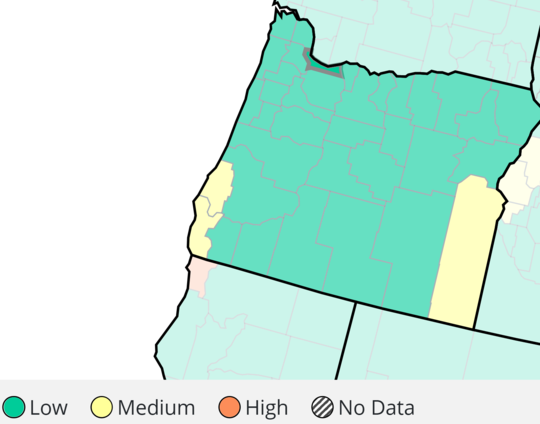
This Week’s Wastewater Monitoring Report: Both Increases and Decreases
With testing reports giving us just a fraction of infections out there, wastewater monitoring has become a more reliable indicator of the amount of virus in cities around the state. That report is updated each week.
This week’s report, updated on Wednesday, showed mixed results, with the viral loads in some cities rising, and in others falling. Eighteen percent of the cities saw increases and sustained increases (up from 13% the previous week). Fourteen percent showed decreases and sustained decreases (up from10%). Sixty-eight percent showed no change (down from last week’s 77%).
Astoria, Medford, Newberg, and Siletz were the cities showing sustained increases in last week’s report.
OHSU Report Shows Declines in Flu and RSV, Small Increases in COVID
Another OHSU forecast report was released on Wednesday, February 15. It is now being called the “OHSU Oregon Hospital Forecast and Trends: COVID, Flu, RSV.”
It uses data provided by OHA and others that project how fast the viruses may spread in the population and provides projections on possible outcomes, including infection rates and impacts on hospital capacity. The lead author is Dr. Peter Graven, Director of OHSU’s Office of Advanced Analytics.
This week’s report—the first in nearly a month—shows overall stability in the disease metrics, with small COVID increases and ongoing declines in flu and RSV. The primary forecast has been revised upwards to include the effects of XBB.1.5. This current trend of small COVID increases should peak in two weeks.
Here are some details:
- The number of people in the hospital with COVID-19 in Oregon rose to 250 in the prior two weeks, from a low of 203 on Feb. 4.
- Available beds have increased during the last three weeks.
- The XBB.1.5 strain of COVID is showing up in more samples in Oregon, about 50%.
- The number of emergency room patients waiting for beds, and the number of available beds, remain the same as before the winter surge in respiratory illnesses.
- Flu and RSV have dropped quickly to low levels in Oregon. COVID has risen slightly.
- COVID-19 levels in wastewater stayed mostly flat, with some increase in the prior two weeks.
- The rate of people going to emergency rooms for COVID was flat, at 2.9% of emergency room visits in Oregon.
- The percentage of positive COVID tests has increased to 12.6% in Oregon.
- There were 5 children with COVID in Oregon hospitals.
- About 5% of the people in intensive care units in Oregon had COVID.
- Since the last forecast, the XBB.1.5 strain of COVID-19 has spread swiftly in Oregon. This may be tied to the slight increase in the number of people with COVID in the hospital.
- The forecast shows a peak of 283 people with COVID in Oregon hospitals on March 4, driven by the XBB.1.5 strain and its ability to spread and break through immune defenses.
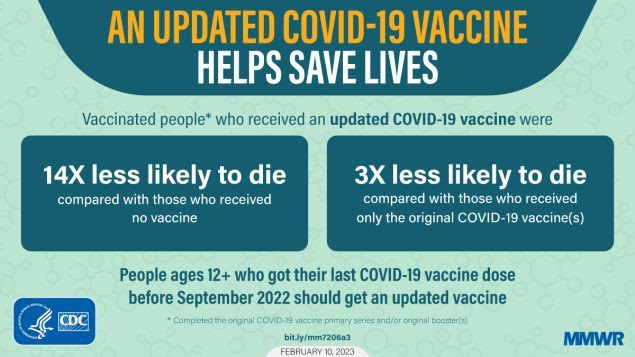
COVID Q & A from OHA (from OHA weekly newsletter)
Dr. Paul Cieslak, OHA senior health advisor and medical director, Communicable Diseases and Immunizations, and Dr. Dean Sidelinger, OHA state health officer and state epidemiologist, answered today’s questions.
Q: The OHA newsletter recently included a warning about the annual School Exclusion Day for required vaccinations on Feb. 15, specifically noting that COVID-19 vaccinations aren't required for school. I've been reading the OHA newsletter since March 2020 and have followed advice on the importance of COVID-19 vaccinations for my children. I don't dispute the importance of any required vaccinations, but I review OHA's disease dashboards and there have been 62 cases of measles in Oregon in the last 20 years, which is a required vaccination, versus over 100,000 pediatric COVID-19 cases, 1,000 child hospitalizations and 15 deaths since 2020. Why isn't the COVID-19 vaccine and current boosters required for school attendance? – Elliot, Portland
A: “Thank you for the thoughtful question. The data you cite about measles are a testament to the success of measles, mumps and rubella (MMR) vaccinations – and of school requirements for certain vaccinations – in virtually eliminating measles in Oregon. Measles, and the MMR vaccine, are different than the situation we face with COVID-19. The measles virus does not mutate with anywhere near the speed of the virus that causes COVID-19. The MMR vaccine is also extremely effective preventing not only severe disease, but any disease from measles, mumps or rubella, with significant long-term protection. We hope that one day the MMR vaccine will eradicate measles from the globe.
“By comparison, COVID-19 is evolving rapidly, and while protection from severe disease in those up to date with recommended boosters appears to be long-lasting (at least for the two years we’ve had vaccines available), protection against getting infected and being able to pass the virus to others lasts for a shorter time. To be meaningful, regular boosters will probably be necessary, and we have never required a vaccine that called for annual boosters (such as influenza).
“In Oregon, the Immunization School/Children’s Facility/College Law Advisory Committee advises OHA on rules for school, childcare and college immunizations requirements. In making recommendations, the committee considers multiple criteria. The COVID-19 vaccine does not have nearly the performance as the MMR vaccine when measured against these criteria.
“So, while not required for school attendance, COVID-19 vaccines are still recommended for everyone 6 months and older to help keep them healthy. If parents have questions, they are encouraged to talk with their pediatrician.”
Q: I am 69 years old and received my third booster in September. How do I know if it was a bivalent vaccine? The only info I have on my vaccination card says it was Pfizeromg(?)r. The last two letters are not very legible. I received it at Walgreens in Springfield. – Glenda, Eugene
A: “Glenda, if you received that booster at Walgreens on or after Sept. 2, it was the bivalent booster. When the bivalent booster was authorized by the FDA, recommended by the CDC and endorsed by the Western States Scientific Safety Review Workgroup Sept. 1, the original (monovalent) boosters were discontinued. So, as of Sept. 2, the only booster you could receive was the bivalent booster, either Pfizer or Moderna. It sounds like you received the Pfizer bivalent booster. If you want to confirm, contact Oregon’s immunization registry—ALERT IIS—and ask for your records. When a health care professional vaccinates you, they are required to record that vaccination in the ALERT IIS database, and you can reach the ALERT IIS Help Desk at 800-980-9431 or via email at alert.iis@dhsoha.state.or.us.”
Additional COVID Updates and Links
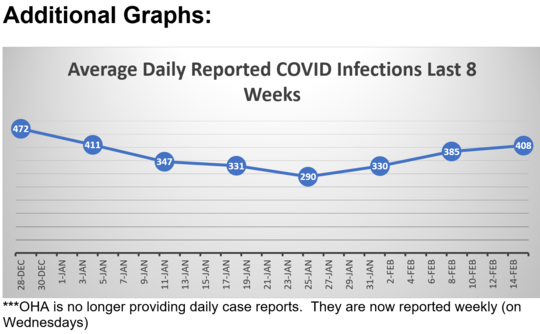

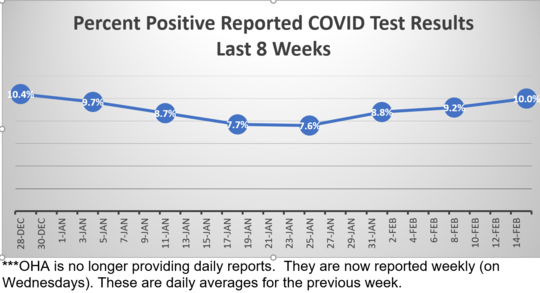


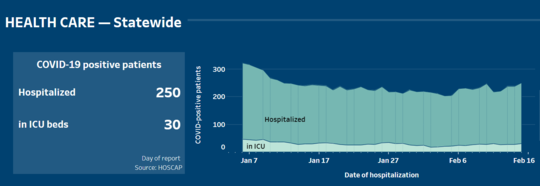
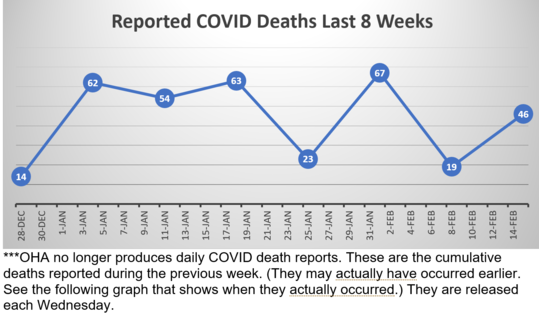

Here again are some COVID resources that you will find useful:
If the above links are not providing you with answers to your questions or directing you to the help that you need, please consider me and my office to be a resource. We’ll do our best to assist you or steer you in the right direction.
 Senator Michael Dembrow
District 23
email: Sen.MichaelDembrow@oregonlegislature.gov
web: www.senatordembrow.com
mail: 900 Court St NE, S-407, Salem, OR, 97301
|